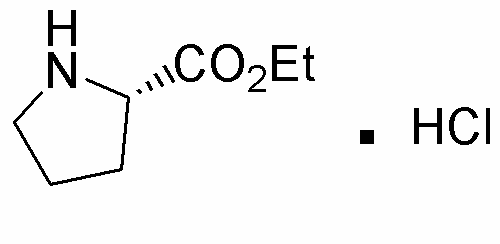L-Proline ethyl ester hydrochloride is widely utilized in research focused on:
- Peptide Synthesis: This compound serves as a valuable building block in the synthesis of peptides, particularly in the pharmaceutical industry, where it can enhance the stability and bioactivity of peptide drugs.
- Chiral Auxiliary: It acts as a chiral auxiliary in asymmetric synthesis, allowing chemists to produce enantiomerically pure compounds, which are crucial in drug development.
- Biochemical Research: Researchers use it to study protein folding and stability, providing insights into enzyme mechanisms and potential therapeutic targets.
- Food Industry: It can be applied in the formulation of flavor enhancers and food additives, improving the taste profile of various products.
- Cosmetic Formulations: The compound is also incorporated into cosmetic products for its moisturizing properties, contributing to skin hydration and overall product efficacy.
Informations générales
Propriétés
Sécurité et réglementation
Applications
L-Proline ethyl ester hydrochloride is widely utilized in research focused on:
- Peptide Synthesis: This compound serves as a valuable building block in the synthesis of peptides, particularly in the pharmaceutical industry, where it can enhance the stability and bioactivity of peptide drugs.
- Chiral Auxiliary: It acts as a chiral auxiliary in asymmetric synthesis, allowing chemists to produce enantiomerically pure compounds, which are crucial in drug development.
- Biochemical Research: Researchers use it to study protein folding and stability, providing insights into enzyme mechanisms and potential therapeutic targets.
- Food Industry: It can be applied in the formulation of flavor enhancers and food additives, improving the taste profile of various products.
- Cosmetic Formulations: The compound is also incorporated into cosmetic products for its moisturizing properties, contributing to skin hydration and overall product efficacy.
Documents
Fiches de données de sécurité (FDS)
La FDS fournit des informations de sécurité complètes sur la manipulation, le stockage et l’élimination du produit.
Spécifications du produit (PS)
Le PS fournit une description complète des propriétés du produit, notamment sa composition chimique, son état physique, sa pureté et les exigences de stockage. Il détaille également les plages de qualité acceptables et les applications prévues du produit.
Certificats d'analyse (COA)
Recherchez des certificats d'analyse (COA) en saisissant le numéro de lot du produit. Les numéros de lot et de lot se trouvent sur l'étiquette d'un produit, après les mots « Lot » ou « Lot de fabrication ».
Numéro de catalogue
Numéro de lot/série
Certificats d'origine (COO)
Ce certificat d'exploitation confirme le pays dans lequel le produit a été fabriqué, et détaille également les matériaux et composants utilisés et s'il est issu de sources naturelles, synthétiques ou autres sources spécifiques. Ce certificat peut être requis pour les douanes, le commerce et la conformité réglementaire.
Numéro de catalogue
Numéro de lot/série
Fiches de données de sécurité (FDS)
La FDS fournit des informations de sécurité complètes sur la manipulation, le stockage et l’élimination du produit.
DownloadSpécifications du produit (PS)
Le PS fournit une description complète des propriétés du produit, notamment sa composition chimique, son état physique, sa pureté et les exigences de stockage. Il détaille également les plages de qualité acceptables et les applications prévues du produit.
DownloadCertificats d'analyse (COA)
Recherchez des certificats d'analyse (COA) en saisissant le numéro de lot du produit. Les numéros de lot et de lot se trouvent sur l'étiquette d'un produit, après les mots « Lot » ou « Lot de fabrication ».
Numéro de catalogue
Numéro de lot/série
Certificats d'origine (COO)
Ce certificat d'exploitation confirme le pays dans lequel le produit a été fabriqué, et détaille également les matériaux et composants utilisés et s'il est issu de sources naturelles, synthétiques ou autres sources spécifiques. Ce certificat peut être requis pour les douanes, le commerce et la conformité réglementaire.


